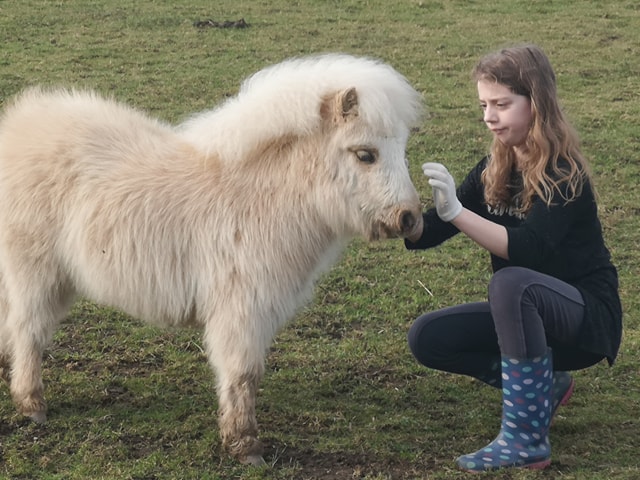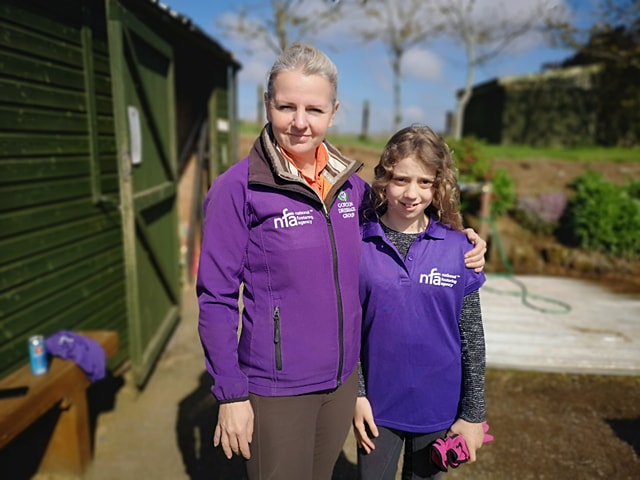Find out if you could be a foster carer
In a few simple questions, you’ll know if you’re suitable to apply to become a foster carer.
Having been involved in behavioural work with horses for over 25 years, NFA Scotland based Support Worker Sarah has translated her passion for working with the animals into her horse therapy based work with children and young people cared for by NFA foster carers.
The results have been nothing short of astounding. Equine therapy has become an increasingly effective method of helping both children and adults with emotional and behavioural difficulties to overcome some of their unique social challenges. The reduction of symptoms of anxiety and depression, as well as the emotionally stabilising effects made possible by this fun and informal activity cannot be underestimated.
“My life has involved working with horses in some way for about 40 years, as I’m 47 now, and also do a bit of work for the RDA (Riding for the Disabled Association)’, Sarah explained.
‘I’ve been doing behavioural work with horses themselves for a long time now, and that started because my brother was killed in a road accident. I was just devastated at the time, so I bought this horse that turned out to be absolutely bonkers, but looking back it was obvious that I needed him and he needed me‘.
‘I’d ridden racehorses in the past and mucked in at stables, but he was very aggressive and difficult to train so I was forced to learn different techniques so that I could get through to him. I then went on to have riding lessons from the likes of Ian Stark and Lucinda Green, who are some of the world’s best ever riders. He was a tiny horse at 15 hands tall, but we still managed to compete in events and dressage. He’s fabulous and at 32 he is still going strong. He is amazing with children too’.
‘I’m on a livery yard and I have my own two horses. We’re fully insured and it doesn’t cost anything for the children to come out here – with foster children in the Aberdeenshire area being who we support at the moment”.

Riding activity at the livery
Formal therapy sessions with young people continue to play a significant role for therapists and support workers. When working one-to-one, they are able to help children who might need to talk through what’s happened in their past and understand how it may be affecting them in their daily lives.
Widely used talking therapies such as cognitive behavioural therapy (CBT) can help children understand more about managing their emotions, such as why they often feel anxious, sad or angry, and will be able to learn coping strategies that can help them take positive steps both at home and in school.
However, because every child is unique in terms of their personality, past experience and how they respond to others, alternative activities such as horse therapy can complement more formal therapeutic settings in helping them learn, grow and develop as people.
“Most children like animals so it always feels quite informal‘, Sarah continued.
‘They’re usually outside and they get to stroke the horses and learn about all the sensory elements of animals including how they look, smell and feel as they touch them. I do a lot of join up, which is a form of psychology based on body language‘.
‘It’s about how the way we move and act affects the horses, so you have to switch things around and use body language that the horse will understand. What happens then is that the horse will follow you everywhere and do things without a head collar or lead.‘

Young person tends to pony at the livery
‘The children can then get the horse to do all sorts of things without the horse being restricted. Also, as many of the children that come along will have social and emotional difficulties, it is a great opportunity to show these young people how important their body language is and how this will be interpreted by others, including how intimidating some movements can be even for a big animal’.
‘The benefits of horse therapy are very subtle, as the children often don’t realise that they are improving their communication skills or learning to take responsibility for other living things, as they are usually having so much fun”.
“We did a ‘Pony Fun Day’ earlier this year. It’s really nice to get all the children attending the sessions, working both independently and as part of a team. They’ve got to follow instructions so their concentration has to be developed a little bit before they are able to work with big animals‘.
‘When we organised the day, the foster carers came along as well as the young people. Some of them knew all about horses and others didn’t, but afterwards they were all requesting a carer engagement day, which we are hoping to do in the future – as it had been as relaxing for them as it was for the children and young people”.

Nicky, Scotland dressage rider who regularly helps out at the livery, and a young person
The therapeutic work of Sarah and the staff at the livery in Aberdeenshire has not gone unnoticed. Local authority representatives have observed several one-to-one sessions, including a girl who was able to talk about everything she was doing with the horses, after having previously struggled to vocalise her thoughts in her day-to-day life.
It soon becomes apparent that heartwarming stories such as these are commonplace. Many children visiting the livery to help out and chat to staff are able to take away the immense benefits of their experiences and apply it elsewhere, as Sarah explained:
“There is one girl who will always want to get involved, unless it’s pouring down with rain! She will help bring the horse in, give it all of its herbal supplements and make up the feeds. She has learnt direction and it has helped with her schoolwork as her ability to concentrate has increased massively. Her social skills have also increased as she is having to talk to some of the other people that are on the yard‘.
‘You can now ask her questions such as ‘Why does one of our horses eat seaweed’? and she will reply by saying, ‘It’s because it’s full of biotin, which is good for their hooves’. It’s the same if you were to ask about why we feed another horse a flour mix, which is because he has an upset stomach, so the flour will reduce pH levels‘.
‘She has learnt all this without me even having to try and teach her. The best way anybody learns is when they can build their knowledge in an enjoyable way”.
Sarah is hoping to offer an introduction to horse therapy sessions to more young people across Scotland’s Central Belt, with the potential for using other facilities to reach as many children and young people under NFA’s care as possible:
“I’m hoping next year to use a friend’s livery yard who lives in East Kilbride, so that we can offer the therapy sessions to those in Central Scotland, even if it was having the option to go once or twice during the summer holidays”.
Sarah aptly summed up the positive influence these sessions are having and the enormous impact they can have for many other young people across the nation:
“It’s just a non-structured, informal activity where nobody is having to overly prompt children with leading questions such as ‘Why do you feel like this?’ or ‘Why has this happened’? which doesn’t always work for every child. It’s amazing what becomes of these sessions“.
Find out more about the brilliant work our staff like Sarah and our community of dedicated foster carers at NFA do to improve the lives of children and young people every day.